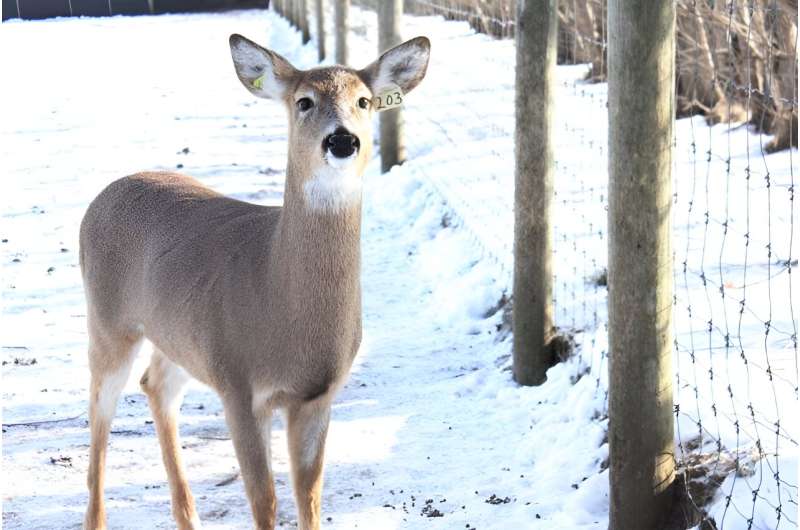This article has been reviewed according to Science X's editorial process and policies. Editors have highlighted the following attributes while ensuring the content's credibility:
fact-checked
trusted source
proofread
Identifying biosecurity to prevent chronic wasting disease transmission among deer populations

As chronic wasting disease (CWD) ravaged deer populations across the country in recent years, studies have primarily focused on how CWD can jump from farmed herds to wild deer, with little attention given to how transmission may occur from wild deer to those living on farms.
University of Minnesota researchers recently assessed the risks associated with the introduction of CWD to farmed deer herds in Minnesota, Pennsylvania and Wisconsin. Because CWD is highly infectious and sometimes fatal disease for deer with no treatment or vaccination available, strategies to prevent its spread are primary tools available to keep these animals healthy.
The study, published in Preventive Veterinary Medicine, examined various transmission pathways and their associated risk factors for farmed deer herds. The researchers collected data from 71 herds in three states, including both CWD-infected and disease-free herds. The data included deer movements, regulatory violations, CWD test results and distances to infected wild deer. They also interviewed deer farmers about their management practices.
The study identified two primary pathways of CWD transmission:
- Direct contact with infected farmed deer. The importation of deer from herds that were later found to be CWD-positive posed a substantial risk of disease introduction to susceptible farmed deer, with 32% of CWD-infected herds studied experiencing this exposure. While current regulations aim to prevent such transmission once infected herds are identified, this risk remains, though it is not the primary risk for introducing CWD to farmed herds.
- Indirect contact with infected wild deer. Several factors were associated with the risk of CWD transmission from infected wild deer to farmed deer, including CWD-positive wild deer frequenting areas within five kilometers of a deer farm, the presence of scavengers inside or near the perimeter fence, the use of single perimeter fencing, and the use of several practices that could attract scavengers through the fence, including placing water sources near the outer perimeter fence.
"While media attention has focused on CWD risks from infected deer farms to wild deer, what has been overlooked is that CWD can also be transmitted in the other direction—from infected wild deer to farmed deer," said Scott Wells, a professor in the College of Veterinary Medicine.
"This study identifies risks for CWD transmission from infected wild deer to farmed deer, especially through indirect pathways involving other animals that may act as carriers for disease movement. Voluntary implementation of biosecurity practices can reduce these risks and help protect farms from CWD."
The team used the results from this study and other research to develop and refine biosecurity information and recommendations, including a CWD Biosecurity Assessment tool that deer farmers can use to evaluate and mitigate the risks specific to their farms.
The study emphasized the need for further research into indirect pathways of CWD transmission from wild deer to farmed deer herds, as well as the importance of ongoing efforts to control CWD in wild deer populations. An improved understanding of CWD risks can inform the further development of effective biosecurity protocols to prevent CWD introduction to farmed deer herds.
More information: Michelle L. Schultze et al, Herd-level risk factors associated with chronic wasting disease-positive herd status in Minnesota, Pennsylvania, and Wisconsin cervid herds, Preventive Veterinary Medicine (2023). DOI: 10.1016/j.prevetmed.2023.106000
Provided by University of Minnesota


















